1.
Early in the afternoon of Wednesday, October 17, I got a call from a friend and fellow alumnus of CalArts with the news that Michael Asher had passed away. I set down the phone and quickly scanned the obituaries in the Los Angeles Times and the New York Times. And then that sinking feeling set in. I had not been in contact with Michael for some years, but in the nature of a death both expected and untimely (I was aware he was in poor health), I was not prepared for how the news hit me. I was overcome by a wave of remorse: remorse born of a guilty conscience, of kindnesses not paid and obligations unmet; a remorse too late now for any remedy.
I imagined the calls passing back and forth among Michael’s colleagues, and especially among his former students, exchanging the various stories and anecdotes that, as if through sympathetic magic, could summon him back. I imagined with equal clarity the many texts—now that his oeuvre is a closed book—that could proceed unhindered by the living artist’s stubborn irascibility. How would these texts now position him and to what end? As a practitioner of “situational aesthetics,” that procedural version of site-specificity? What, then, of his absolute refusal to conflate the commodity form and the art object? And what of his attitude towards history, or labor, or his longstanding fascination with the intricacies of infrastructure?
These questions are further complicated by an approach to artistic practice that left few physical traces. Michael’s work was site-specific, but he took the procedure of approaching a site and using “just elements which already existed without a great modification to the space” through all its possible permutations, this disarmingly simple premise eventually encompassing the synchronic and diachronic dimensions of site—phenomenological time and perceptual space, contingency and determination, ideology and history.1 And yet, despite the scarcity of physical traces left by his artistic practice and his absence from the many indices by which the art world calculates influence and canonical significance (auction prices, gallery shows, presence in museum and private collections), despite his stubborn and unfashionable solidarity with the working class, and a concomitant abhorrence of the sort of lionization that might endanger his fealty to the category of remunerated labor, I would describe him as the most influential artist of his generation—an ironic superlative considering how neatly he evaded most of the criteria customarily employed in according artistic influence. 2
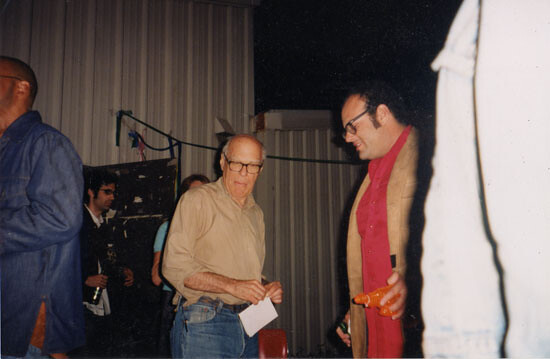

2.
I didn’t know who Michael Asher was when in the fall of 2000 I entered graduate school. I recall speaking by phone to a second year grad student who mentioned Michael Asher as one of the art department’s most interesting figures, leader of a marathon critique course that met every Friday.
“Michael who?” I asked.
“He’s not so well-known,” she answered. “He’s more of an artist’s artist.” She described a work involving heating pipes that I can now identify as his 1992 installation at Kunsthalle Bern, where he relocated the Kunsthalle’s steam radiators to the building’s foyer, connecting them to their respective sockets with a network of steel pipes. Thus informed, on registration day, when CalArts’ faculty members assembled in the main gallery, sitting behind folding tables to sign students up for courses, I approached Michael Asher, asking if he thought it advisable for an incoming student to take his course. “Why not?,” he said, and smiled what I came to know as a characteristic smile, as if he were amused by some private joke.
For those unfamiliar with the Southern California art scene, it is difficult to fully appreciate Michael’s influence. It stemmed not only from his pedagogic reputation and the unimpeachable quality of his work, but also from a certain Asher mythos (or, more accurately, ethos). While attending CalArts, I heard all the rumors then in circulation: that his apartment was more of a studio; that he slept on a mattress on the floor; that his closet contained nothing but identical button-down shirts, and his kitchen cabinets, books instead of food; how incessant work and a monochromatic diet taken at a Greek restaurant near his house led to his first physical collapse; how after his mother, Betty Asher, died, he systematically gave away her art collection without regard for personal gain. The germ of a fascination most other artists would envy but to which Asher himself seemed utterly indifferent was contained in the near literary conceit of an art collector’s son who developed a practice in which no tangible or sellable object was produced, who not only eschewed artistic commodification but chose to lead a life of such austerity that his refusal of parental largesse appeared like a badge of honor. At least in Southern California, the source of the fascination surrounding Asher the person and Asher the artist lay in this symmetry between his work’s absolute refusal of commodification and his personal renunciation of material acquisitiveness. No other artist I am familiar with was as consistent in carrying over the ideas he espoused in his artwork into the terrain of lived experience.3
Since 1977, Michael had earned a large portion of his income teaching at CalArts. In a school that prided itself on experimentation, his post-studio critique class became arguably its most famous innovation.4 The term “post-studio” was originally coined by John Baldessari, who employed it as an alternative to “conceptual” (and who, coincidentally, first brought Michael to CalArts), but it is Asher who is indelibly associated with it. In my mind, post-studio is scarcely associated with conceptual art, but involves, rather, applying a set of non-formalist criteria to the evaluation of artworks. Beginning Fridays at 10:00 a.m., two students presented their work consecutively, with discussion continuing until mutual consensus deemed it time to stop. Ignoring all scheduling and durational considerations, the class sometimes lasted long into the night—an exhaustive and exhausting approach to critique. (His Los Angeles Times obituary quotes Asher from a 2006 interview: “I throw away the clock. There is never enough time to get everything said.”5) The end result of these sessions was invariably the establishment of, to quote Michael, “the disparity between what a person says their work is about and what is actually being observed”: where a work’s internal logic broke down; where it relegated to a representational schema what the artist wished to produce as a function; where the often vaguely framed or incoherent intentions of the artist were in themselves contradictory.6 If, as Lacan said, the unconscious is structured like a language, it is also a tongue that marshals speech, without our cognizance or agency, to its own inscrutable ends. The process of submitting to critique, of observing it or participating in it, felt not only revelatory of how ideology becomes physically embodied in reification, but also discomfiting, for it demonstrated without fail the inevitability with which one’s neurotic mentations penetrated the structural and conceptual schemes of one’s art practice.
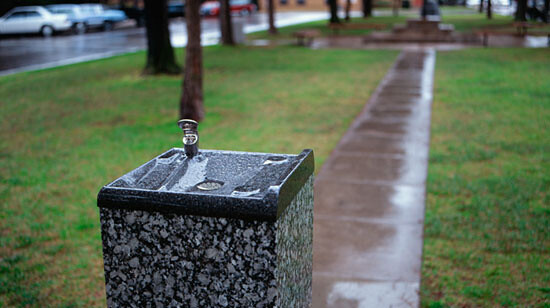

Post-studio critique was mythic, and the almost ritualistic set of conventions that lent it this status (place, duration, discursive scene) were the perhaps necessary outward traces setting it apart as event, as occasion. Some of this had to do with CalArts’ unique architectural qualities. Built into a sloping hill, the institution’s main building is abundantly supplied with classrooms devoid of natural light, and Michael’s course took place in such a room, giving what occurred there the sense of existing apart from the rhythms of everyday temporality. I once asked him why he chose this particular classroom, which possessed the added disadvantage of heightening postprandial somnolence. He answered—and something of this exchange has the Asheresque quality of a levity masking more consequential matters—that he chose a classroom without windows so we would be more aware of the sun.
While I recall few particulars of the discussions that took place in post-studio critique classes, I do remember discussions having a hermetic quality, an unduplicatable gestalt. The circling and at times frustrating recursivity of a discussion thread would warp back on itself like a Möbius strip, before eventually leading us to the kernel at the center of a work’s failure. What transpired was often contextual, resistant to description. Roland Barthes used the term “grain” to describe the uniquely embodied quality of vocal music. One might equally apply the term to the characteristics of thought—the grain of thought—as being the unique and irreducible surplus of a sequence of logical or analytic statements. A turn of phrase, a characteristic intonation, a way of placing stress on a concept are also inseparable qualities of thought, and it is typical of the influence of Michael’s thought that this idea is at once cerebral and inseparable from notions of embodiment. The alchemical process that transformed our criteria into something like insight remains difficult to identify. I suppose this is just a complicated way of saying that what constitutes a gifted teacher is not so much an ability to transmit knowledge as the talent for creating an environment where knowledge is receivable.
I once asked Michael how he got the idea for his post-studio course. He answered: “Plato.”
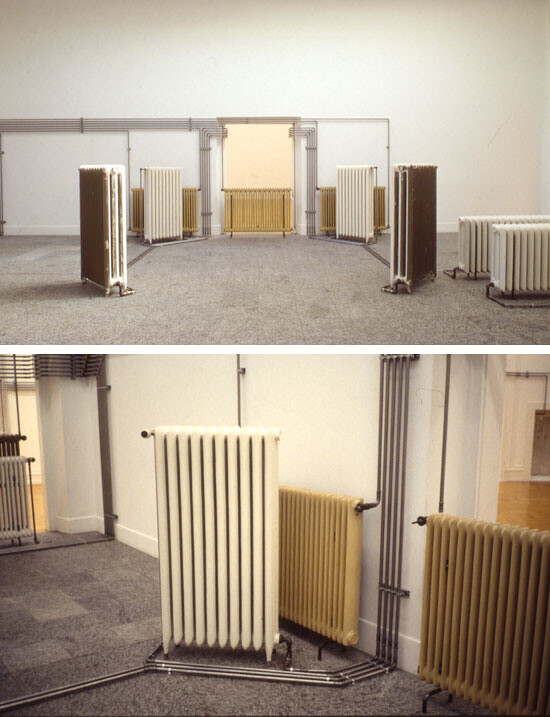

3.
In the summer of 2002 I graduated from CalArts, and that fall I began working for Michael as a researcher on a project that remains unrealized—an analysis of the adaptive re-use of factory space by contemporary art institutions in the European Union. In fact, the essay you are now reading may be the first public discussion of this project.
As I understood it, Michael was researching adaptive re-use for a prospective show at the Generali Foundation in Vienna, an institution itself housed in a converted hat factory. One permutation of Michael’s eschewal of adding anything to a site had previously resulted in a diachronic approach to site-specificity. His 1992 work for BOZAR in Brussels, for instance, demonstrated how extrapolating from a site’s prior function (in that case, a newspaper archive) could offer insight into how any specific site “is covered over by realities, representations, decors, and settings … a serried network of semblances” extending far beyond a particular locale.7His proposal for the Generali Foundation repeated this approach on a grand scale, encompassing not only the particulars of the Generali’s architectural history, but the broader social, political, and economic transformations in which it was enmeshed.
To begin work, Michael asked me to come by his apartment in an anonymous section of West Los Angeles, near where the 405 and Santa Monica Freeway intersect, to familiarize myself with the extant research. He met me at the door, ushering me into a modest one-bedroom apartment, a kind of reduction of your typical postwar ranch-style house. The living room was dominated by rows of black file cabinets; in a corner opposite the front door, a piece of plywood covered with butcher paper and mounted on trestles served as Michael’s desk. Next to a small adjacent kitchen stood a grey metal bookshelf. Each shelf was secured with a bungee cord against the threat of earthquakes. The only other pieces of furniture consisted of two chromium-plated tubular steel chairs, whose upholstering consisted of little more than those pieces of desiccated foam padding still adhering to their backing, and a replica of a Gerrit Rietveld armchair given to him, Michael said, by a former student.
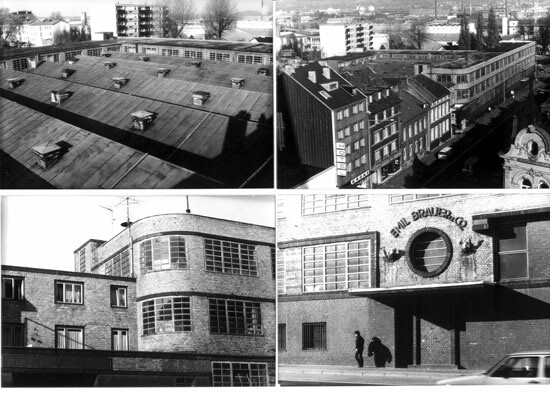

Michael positioned one of the steel chairs in front of a narrow gap between two file cabinets overlaid with a piece of plywood, creating for me an improvised desk, and explained the research. He detailed how he and the other researchers working on the project had set about identifying institutions similar to the Generali—institutions housed in converted factories, showing contemporary art, and possessing international collections. Then, handing me an extra key to push through the front door mail slot when I finished, he got up to leave for a doctor’s appointment. On his way out, he glanced around the apartment, and in his laconic way said, “Yeah, there’s a lot to see here.” Then he left.
A few days later I began my work in earnest. Assigned to locate relevant institutions in Austria, Germany, Scandinavia, and the former Eastern Bloc, I started the search by combing through a extensive list of museums, eventually investigating in greater detail an Austrian institution, a former salt warehouse in the Tirol. Michael gave me a list of thirteen questions that concerned the material history of the Salzlager, covering all changes of function and ownership, architectural modifications, and the prior use and ownership of the land before the Salzlager was constructed. The work was slow and exacting, and my correspondence with Austrians knowledgeable about the salt industry frequently delayed by their vacations and travel plans. It was also complicated by Michael’s admonition that I avoid using his name in correspondence. This directive piqued people’s curiosity rather than limit their interest in my employer’s identity. I eventually submitted an extensive report encompassing not only the built history of the hall, but the history of the Austrian salt industry itself. My conclusion, however, was anticlimactic: the Salzlager could not be included in the project as it had no permanent collection. Since the local municipality had withdrawn funding, it was no longer even used for exhibitions, but was now rented out for parties, weddings, and festivals.
By the time I completed this report, I had relocated to Berlin with my then-partner, Christine Würmell, with whom I collaborated on much of the research. Having eliminated all the sites in Austria, we focused our attention on German institutions, eventually identifying four museums that fit Michael’s criteria. It was immediately apparent that our research was not going to be straightforward. It was not only the effects of the two World Wars and their disruption to German society that caused our difficulties: even relatively simple cases presented unforeseen complications. The Ludwigsforum in Aachen, for instance, is housed in a former Emil Brauer & Co. umbrella factory, but when we contacted the city archive to ask how many different umbrella models the factory produced, we learned that, besides normal umbrellas, the factory also made custom-built ceremonial umbrellas for royalty—a tantalizing fact, but in the context of our research, an exasperating wrinkle.8
Ceremonial umbrellas were nothing compared to the complexities we encountered elsewhere. Take the Neues Museum Weserburg. It is located on a narrow spit of land—the “Teerhof”—at the northern end of a peninsula separating the Weser and the Little Weser Rivers, an area already well developed in the thirteenth century. The Teerhof premises later to become a museum went through a dizzying number of changes in architecture and use before they were utterly destroyed in bombing raids during WWII. After the war, its main tenant, the Schilling Coffee Company, set up their roastery in the building’s cellar before rebuilding the premises, which became a museum in 1991. In the age of the internet, perhaps this welter of information does not seem too great a challenge, but in the years before Google, locating information about the history of the successive businesses occupying the premises was difficult, to say nothing of the various renovations and additions, a fact compounded by Michael’s request that we avoid contacting the museum directly.9
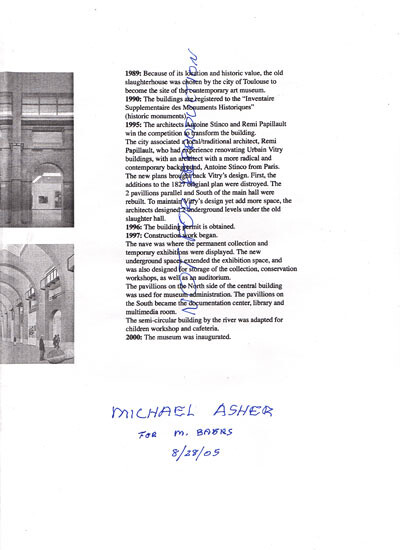

The apotheosis of our research difficulties, however, was the ZKM Museum of Contemporary Art in Karlsruhe, an institution housed in a section of what was once the largest munitions factory in Europe. Construction of the Industriewerke Karlsruhe plant, a building consisting of a row of ten atria, was completed just as WWI came to an end. Just as it came on line, the Versailles Treaty stipulated the factory shift to non-military manufacture. In the interwar period, it produced a dizzying array of products ranging from bicycles to kitchenware. Considering the confusion of the immediate postwar economic situation and in the absence of a local industrial archive, finding out which goods had been produced in the specific atria housing the art museum appeared a task of insurmountable difficulty.
Christine and I worked on Michael’s research until I moved to New York to attend the Whitney Independent Study Program (ISP), and from there I rotated between the ISP and the main branch of the New York Public Library. In August I returned to Berlin in a state of profound emotional distress, but with an abundance of research. Despite my disequilibrium, or perhaps to combat it, I began drafting updated reports and researching a final institution, the International Artists’ Museum in Łódź, Poland. In 1795, Poland was partitioned by Germany, Russia, and the Hapsburg Empire (the third and last partition in a twenty-three-year period) and carved into separate administrative zones. Then in the 1830s, following the Polish economy’s “liberalization,” investors and managers from Germany and England flocked to the German zone, which encompassed Łódź, to set up textile mills; the International Artists’ Museum was housed in such a mill. It presented its own unique difficulties for the researcher. Finding out the exact size and address of the museum was no easy task, and attempts to locate via telephone archival material in Łódź’s various historical museums was also frustrated by employees who were averse to communicating in anything but their native tongue.10Then I made contact with a British entrepreneur and specialist in industrial preservation who was involved with local efforts to preserve Łódź’s derelict but mainly intact nineteenth-century industrial landscape. As coincidence would have it, he was organizing a conference in Łódź and urged me to attend. One after-effect of the Communist era, he explained, was the reluctance of museum and archive employees (in which Łódź’s industrial past had been carefully documented) to share information via phone or e-mail. All the information I was looking for was carefully preserved in the archives, said the British entrepreneur, but I would have to go there in person.
I called Michael and communicated the entrepreneur’s advice. He was unwilling to fund the trip. I was not especially surprised, as he had previously resisted all suggestions that we visit sites. I knew Michael was funding this research mainly out-of-pocket, and I knew his generosity as a pedagogue did not extend to financial matters. Nonetheless, I could not see how to proceed with his research. I completed my pending reports, packed up the research materials I had collected at the New York Public Library over the summer, and sent them off, considering the matter closed. Although there were occasions when working on a project by the artist I admired more than almost any other was immensely satisfying, there were more times when my employment was a matter of frustration to us both. I saw him once more during a visit to Los Angeles the following January. Then we lost contact.
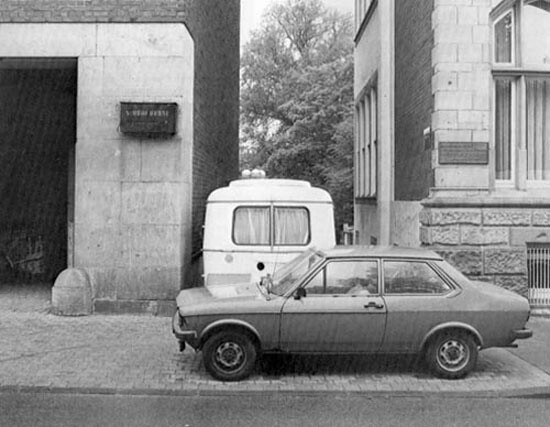

4.
In late October, before leaving on a trip to Vienna, I located what remained of my adaptive re-use research material in a box of old clothes and computer equipment. Amongst the miscellaneous papers and remnants of my research, I found an unopened manila envelope Michael had posted in August 2005. It contained a timeline prepared by a fellow researcher of Les Abattoirs, a contemporary art museum in Toulouse. A note in Michael’s characteristically shaky hand read: “Dear Michael, It makes me truly uncomfortable to send out material like the enclosed. But if it is something that will help you to focus, perhaps it is necessary. If you have any doubt about your ability to protect it please return it. Michael Asher.”
While I am surprised I did not open it, I also see a certain Lacanian irony in the contents of this letter that was delivered but did not reach its recipient. It also made me very, very sad. There is no further reason now to protect the document enclosed. Today, in fact, the obverse is the case.
The matter of Michael Asher’s final, unrealized project is of more than peripheral importance, and I have described my experience at length to ensure that the project’s conceptual parameters are marked with his imprimatur. I view it as the culmination of his work on the intersection between site, class, ideology, and history—his interest in understanding the real as a negotiation between the historical and structural basis of reality, arrived at through “epistemological procedures of which the archive is the cipher and research the mode.”11 More specifically, by focusing on the architectonic conflation of sites of industrial production with sites of cultural production, Asher created a neat one-to-one relationship between the normally separate spheres of economy and culture—articulated not as an exterior fact but as the basis of every exhibition staged on the Generali Foundation’s premises.
But why was it never realized?
While in Vienna, I spoke with a staff member at the Generali Foundation. I learned discussions between Michael and the Foundation dated back to the mid-90s, and the adaptive re-use project was only one of several concepts considered. While it was taken seriously enough for the Generali to launch its own adaptive re-use investigation, ultimately Michael and former director Sabine Breitwieser elected to pursue a retrospective exhibition—a concept that had also been under discussion. Suffice it to say that in 2006 Michael returned his first payment for the sale of No Title (1965-67) (Forced Air Column) to the Foundation and with that the matter was concluded. Exhibition planning is rarely a straightforward affair, especially when it involves an artist as meticulous as Michael Asher: this account should be considered nothing more than a preliminary sketch. In any event, it is not the time to delve further into the matter.
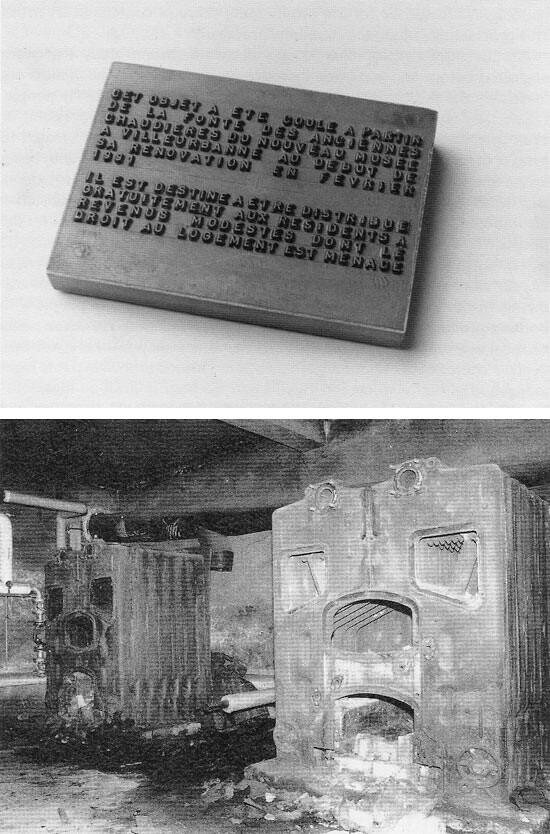

5.
I once heard Mary Kelly say that most male conceptual artists used the language of scientific objectivity without considering the question of their own desire in the matter. While I do not exactly include Michael Asher in the category of “male conceptual artist,” the nature of his desire is of some consequence. What Michael intended his adaptive re-use project to look like remains unknown, although fellow researchers say he continued working on the project after the Generali Foundation exhibit’s cancellation. He took it seriously enough for it to point to the questions I raised at the beginning of this text: How will his artistic legacy be framed? How will the paucity of artifacts relating to his practice effect this process? In refusing the art object as such (including foreclosing the possible fetish-status detritus of his installations might acquire by contractually obligating host institutions to destroy any remainders), Michael insisted on the absolute temporal and spatial specificity of his artwork. With the exception of three permanent installations, Michael’s legacy exists solely in catalogues, books, and publications, and in the documentation collected in his personal archive or in the archives of the institutions he worked with—a triumph of the indexical over the material object.12 But his work also resides, it can be said, in the minds of those who have encountered his oeuvre, since even in its paper form, Asher’s work retains a remarkable plasticity (although there the very clarity of his concepts carries with it the danger of obviating the spatial and experiential—i.e., sculptural—aspect of his work).
This type of mediation gives rise to a danger that is now quite clear: without the actual work itself (and with the idea of reconstituting nearly every work in his ouevre amounting to a perversion), it is up to his professional interlocutors to enact a secondary enframement, describing for us what the various interventions Michael created meant and who they were meant for. In other words, his legacy risks becoming a plaything bequeathed to critics and art historians. Already one sees some inkling of this process in his several published obituaries, with Jori Finkel of the Los Angeles Times writing that “unlike the work of some other artists grouped under [the institutional critique] umbrella, Asher’s was not fueled by political dogma as much as intelligence and curiosity.” In a similar vein, the New York Times’ Randy Kennedy wrote that Michael “sought to use art to awaken people’s perceptions to the complex, subtle, often unexpectedly beautiful nature of their everyday visual landscape.” While daily newspapers are perhaps unlikely venues for an appreciation of the politics in Michael Asher’s work, that both writers assiduously sideline a concern so consequential to his production portends an ominous trend.
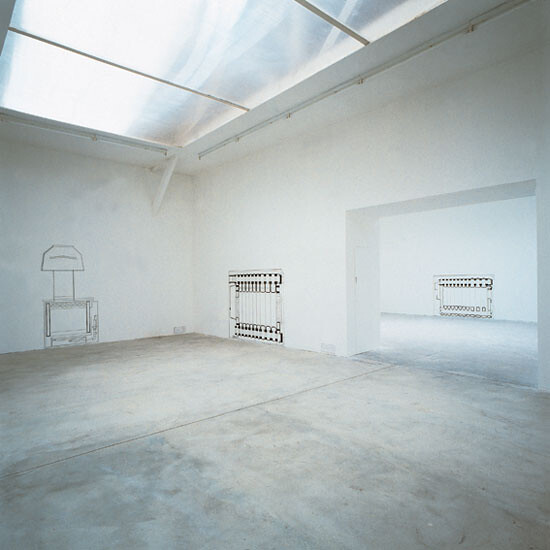

Something has been left out of these obituaries. This omission involves not only the ways in which art institutions buttress the presuppositions foundational to bourgeois subjectivity, but also how, as institutions, they frequently operate in ways contrary to the interests of working class populations—on the semiotic level of affirmative culture and in those concrete instances where art museums act as agents of gentrification. For a project Michael executed at Le Nouveau Musée in Lyon, the obsolete cast iron boiler of the museum was smelted down and transformed into 700 paperweights, impressed on one side with contact information for two local housing rights associations, and on the other with the following statement: “This object comes from the old furnace of Le Nouveau Musée at the beginning of its renovation in February 1991. It is to be distributed for free to people of low income who have housing problems.”13 In his introduction for the exhibition catalogue, Michael wrote,
As the neighborhood of the 3rd, 4th, and 7th arrondissement of Lyon were either in jeopardy of redevelopment or were already greatly transformed as communities which no longer could be affordable to meet the needs of those families whose ancestors established their homes and businesses [there], it was not difficult to understand how a sign of renovation was one of the important keys for speculators’ equations for the justification of future development.14
The more or less recondite arguments found in essays explicating Asher’s work often gloss over this central aspect of his art—that he perceived his practice as both operating in contradistinction to the omnipresent, corrosive logic of the art market, and as a type of art in the service of a particular class: the worker. For Asher, the artist did not abide on some mythic plane of unalienated expression. S/he was constituted, through intellectual or physical work, as one category of alienated laborer.
I don’t think Michael observed developments in the world situation or the world of art with equanimity—especially in the last two decades, when art has come to be spoken of increasingly as one asset among many in a diversified investment portfolio. The high standards Michael adhered to in his personal practice, and in his precise, incessant drive to root out the processes of reification he found in his students, was not without its corrosive effect. I know of at least one student who gave up art after encountering the absoluteness inherent in Asher’s project of critical negation and his refusal to accommodate the market in ways even the most political among us accede to—as a matter of course and a perfect expression of life under late capitalism. His example constituted the terminus of a sort of critical engagement that even in the early 2000s risked appearing quaint when compared with the behavior of his contemporaries. It remained up to us—his students—to rework his procedures for our contemporary ends. Most of us failed, and this failure was also the refusal of an obligation to which Michael never made us explicitly submit but was there as a subtext in the logic of his practice and his life. Perhaps, as recently published reminiscences have emphasized, he was capable of frequent and abundant laughter. What this laughter signified is a different matter.
Unpublished note of Michael Asher quoted in Benjamin H.D. Buchloh, “Michael Asher and the Conclusion of Modernist Sculpture,” in Neo-Avantgarde and Culture Industry: Essays on European and American Art from 1955 to 1975 (Cambridge and London: The MIT Press, 2000), 20.
See Eric Golo Stone, “A Document of Regulation Reflexive Process: Michael Asher’s Contractual Agreement Commissioning Works of Art (1975),” posted August 12, 2011 to Art and Education →.
Two related anecdotes spring to mind. In 2003, when the Los Angeles real estate market was approaching its peak, I asked Michael if the reason he rented an apartment had to do with his refusal of private property. He answered in the affirmative. Similarly, I recall the glee with which he recounted his one realized private commission, where he moved a wall on the southern edge of the house of a Beverly Hills collector eleven inches to the north: in effect, the collector paid for an excision to his private property.
One might speak of a culture of critique particular to Los Angeles-area art schools originating from Michael’s class. Mike Kelley and Jeremy Gilbert-Rolfe both initiated versions at Pasadena Art Center, while Mary Kelly is also known as a proponent of a specific critique style in which students begin by speaking only about a work’s concrete appearance for a given period of time, before proceeding to interpretation. Thus, each academy was invested in advocating for the rigor of its critical apparatus. Although Asher’s class was by far the most storied, by the time I attended art school, Asher’s course, as well as the CalArts visiting artist lecture series, were both far tamer events. As I have written elsewhere, the storied days of the 1990s were passed down to those of us who came later as a time when grad students had forsaken object-making altogether in favor of discourse and nurturing antagonisms that were often vented in Michael’s class. With some regret, I fail to recall an occasion when the level of rancor I experienced exceeded what might occur on your average high school debate team.
In an oft-repeated quote, Barbara Kruger is said to have advised CalArts students to take Michael’s class because no one in the art world would ever devote four or five hours to talking about their work. In essence, then, what Michael Asher offered in his class was the gift of time (just as the temporal specificity of his work offered another sort of gift of non-exchangeable, unequivocal time). There is reason for further reflection here, for while Michael established a contract for his work based on wage labor, it occurs to me now that the relationship between his salary from CalArts and the amount of time he devoted to teaching his class was also organized to emphasize its relation to the gift. There is a passage in Given Time: I. Counterfeit Money where Jacques Derrida elaborates on the gift’s temporality: “The gift is not a gift, the gift only gives to the extent it gives time. The difference between a gift and every other operation of pure and simple exchange is that the gift gives time. There where there is gift, there is time. What it gives, the gift, is time, but this gift of time is also a demand of time. The thing must not be restituted immediately and right away. There must be time, it must last, there must be waiting—without forgetting [l’attente—sans obubli]. It demands time, the thing, but it demands a delimited time, neither an instant nor an infinite time, but a time determined by a term, in other words, a rhythm, a cadence. The thing is not in time; it is or it has time, or rather it demands to have, to give, or to take time—and time as rhythm, that does not befall a homogenous time but that structures it originarily.” (Thanks to Christine Würmell for pointing out this passage.) Jacques Derrida, Given Time: I. Counterfeit Money, trans. Peggy Kamuf (Chicago and London: University of Chicago Press, 1992), 41.
I recall one critique concerning a meter-high, all-white, knitted wall hanging that spelled out the word “colonialism.” At one end, a strand of yarn attached to an electric motor slowly unwound the knitting, undoing the substantial labor that had gone into making the piece. We gathered on folding chairs in a semicircle around the work, and slowly the logic of the piece was undone by the critique as surely as by the electric motor—a dehiscence in which it emerged that the artist’s wish for an end to colonialism was more fundamental to understanding the work than anything specific about what colonialism is and how it remains active in our ostensibly postcolonial epoch.
Birgit Pelzer, “Byways of History,” in the catalogue for Michael Asher: Palais des Beaux-Arts de Bruxelles (Brussels: La Société des Expositions du Palais des Beaux-Arts Bruxelles, 1995), 36.
An example of the type of quotidian detail that contributed to remaking the European cultural landscape is found in our answer to question number twelve on Michael’s form: “Q: What caused the transfer in ownership from one owner to another? A: Production stopped in Germany, they only imported umbrellas, and the containers didn’t fit through the entrance [3.8m high and above workers’ apartments]. The factory thus sold the building to the city of Aachen.”
Christine had translated portions of a book on the Teerhof, and while recently discussing the research we conducted, she mentioned that her participation in an exhibition at the Weserburg in 2011 cleared up a great deal of the difficulty in understanding the history of the museum’s premises that we had encountered while reading this text.
As I learned recently from reading the Wikipedia entry on the museum’s founder, Ryszard Wasko, at the time of my research, the museum’s premises had already been sold by the Łódź municipality to a private bank, and this bank had then proceeded to destroy the site-specific works comprising the museum’s collection. I was thus involved, I now realize, in a complicated shell game where the museum’s supporters were trying to conceal this salient fact—which, in retrospect, explains the lengthy gap in the museum’s published exhibition record.
Frederick Leen, “Archive and Index,” in the catalogue for Michael Asher: Palais des Beaux-Arts de Bruxelles (Brussels: La Société des Expositions du Palais des Beaux-Arts Bruxelles, 1995) 52–53.
In footnote 4 of her essay “Procedural Matters: Andrea Fraser on the Art of Michael Asher,” published in the summer 2008 issue of Artforum, Fraser supplies the following helpful information: “Asher has made only three permanent works. The first is a project for private collectors in Los Angeles that he completed in 1978. The second is a 1991 project for the Stuart collection [sic] on the Campus [sic] of the University of California, San Diego, where he placed a fully functional granite replica of a commercial indoor drinking fountain on a grassy island between a flagpole and a rock with a plaque commemorating the Marine Corps training ground that once occupied the site. The third was a project for the international exposition Daejeon Expo ‘93, in South Korea, for which he placed a rock on an island in a man-made lake. On the rock, a text is engraved in Korean: ‘ASSUMING THAT THE ARRAY OF STRUCTURES WHICH CONSTITUTE THE IMMEDIATE SURROUNDINGS WERE DESIGNED FOR US SPECTATORS, IT ENABLES US TO ASK: WHO BENEFITS FROM OUR NAVIGATING BETWEEN DISPLAYS OF CORPORATE LEGITIMATION AND REPRESENTATIONS OF POWER?’”
In the Autumn/Winter 2000 issue of Afterall, Allan Sekula wrote: “The preoccupation with the flows of waste, with plumbing and heating—with what, in American parlance, are termed ‘utilities’—is central to Michael Asher’s work. The realm of culture is always shadowed by the realm of utility, in an often very funny enactment of the old-fashioned Marxist hierarchy of base and superstructure, grafted onto an appreciation of the specific Duchampian origins of the readymade.”
Quoted from Michael Asher, “Introduction,” in Renovation = Expulsion (Lyon: Le Nouveau Musée, centre d’art, 1991), 6. The following is from an interview published in Merge Magazine about Michael’s contribution to the 1999 exhibition “Museum as Muse” at MOMA: Michael Asher: Another indirect aspect of my work deals with the relationship between the working classes and acquisitions and de-acquisitions of works of art by museums. I wondered why these classes oppose de-accession — of course, they are not the only ones. Its one of the things I find very complicated and really interesting. I think one of the reasons is, consciously or unconsciously, they are aware that or they identify with the fact that their labor made possible the purchase of these works of art. Stephen Pascher: How do you mean? Michael Asher: I mean that their labor was responsible for generating enough profits for company owners to purchase gifts. Gifts to museums are often the result of these purchases. Once these works of art become public, that is, part of a museum collection, they become part of the culture of that community, and when institutions de-accession a work or sell it off, they are taking it away from that community — removing it from the consciousness of the community to which the works have become valued possessions. And that’s a speculation, but I really think it’s true that people have a close bond and relationship with these works of art, not only due to their own labor, but due to the fact that they live in these communities. And the works become a part of the communities, and that’s why it’s very hard to unglue them, and where there is opposition. (Michael Asher and Stephen Pascher, “Cave Notes,” Merge Magazine #5 [Summer 1999]: 26.)

